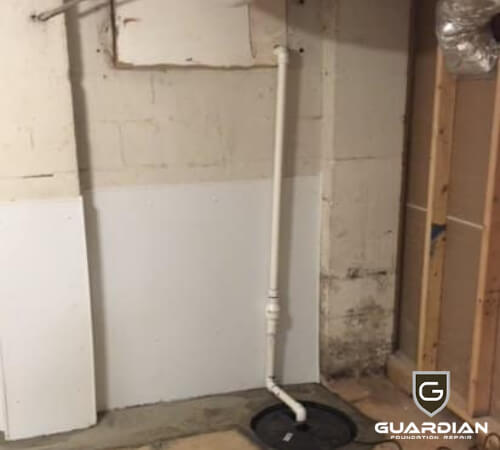Having a crawl space is convenient when you plan to build a home on an uneven surface in Knoxville, TN. It makes construction more manageable and provides you with extra space to store. However, if it rains and the crawl space is not designed correctly, there is a big chance water will get in, and your crawl space will flood.
How Will it Affect Your Structure?
Water leads to moisture, and mold growth rots your floor and wood beams, causing severe structural damage. Mold also gets into insulation, affecting the air quality inside your home. The last thing you want is for your crawl space to create health issues for you or anyone else in the house.
With that said, you need to take quick steps to remedy your crawl space before it becomes a significant issue.
In this blog post, we will discuss how to clean up the flood water and implement a few effective crawl space repair solutions so you can make your crawl space a healthy and productive space.
How to Dry a Flooded Crawl Space
The first thing you need to do is get rid of any standing water. You can use pumps to get rid of the water, but if the crawl space is flooded for a long time, it may take more than one session. You should also try to remove any standing pools by hand so you can reach all the elements of your crawl space.
When you have finally removed all the water, you have to deal with the humidity left behind. You will need to allow the space to dry for at least two weeks to ensure that there are no pockets left full of moisture. To aid the drying process, you should dehumidify the crawl space with a dehumidifier or whole-house fans, which will help circulate the air inside the crawl space. You can also install a crawl space ventilation system to help dry out the area and prevent any future moisture buildup.
Next, you should turn your attention to mold remediation. Cleaning up flood water, freshening the air, and installing proper crawl space encapsulation will be pretty ineffective if there is still mold in your flooded crawl space. If you have been using your crawl space as storage, you need to check your possessions and see whether or not there was anything in the space that has become wet. If yes, you need to remove everything that has been contaminated by mold or spray your items with a disinfectant.
Find Out The Cause of the Flood
It is crucial to find out the cause of the flood to prevent future damages. Below we have listed a few common causes of crawl space flooding.
Improper Drainage System:
Water pooling in your crawl space during a downpour in Knoxville is probably because of your drainage system. But, first, you need to make sure that your gutters are clean and working correctly, which will help to avoid any flooding.
If you notice any missing or broken tiles in the drainage system, you must replace them with new ones. If your drainage system is damaged to the point that you can’t do it by yourself, be sure to consult a professional to get an efficient crawl space drain installation done.
Read here for a complete guide for installing a french drain system in your house.
Improper Grading:
Grading refers to the way in which your crawl space slopes toward the exterior of your home. If it is not done correctly, water can pool up in some places and seep through cracks and holes.
Leaky Pipes:
If you have a leaky pipe inside your home, the water will seep in through the walls and reach your crawl space. You should immediately call a plumber to fix the problem because the flooded crawl space could damage not only your possessions but also cause mold in your structure.
Faulty Sump Pump:
A faulty sump pump will not deplete the water accumulated in your crawl space. If you notice a lack of drainage after rainfall, but you have a sump pump installed, then it is time to make some repairs.
Improper Ventilation System:
If you recently installed a ventilation system in your crawl space, it is a big chance to blame for the water damage. Exhaust fans work by creating negative pressure inside your home. If they are not adequately ventilated outside, they will pull humidity into the space.
If you are unsure whether or not your crawl space is adequately ventilated, hire a professional who can check the whole system.
Poor Drainage Outside of Your Home:
If your crawl space is flooded during a downpour but does not stay that way for extended periods after it has stopped raining, then you probably have an issue with drainage outside of your home. You need to contact a landscaper who can inspect your lawn and discuss ways of preventing water from pooling near your home’s foundation.
Sewage Backup:
The wastewater seeps into your foundation when sewage lines back up and affect your crawl space. If you notice a sewage backup, immediately call a plumber to fix it because this problem can damage your foundation and make people sick if it is left untreated for extended periods.
Practical Solutions to Prevent Crawl Space Flooding
Once you know the cause of the flooding, you can start looking for ways to avoid crawl space flooding in the future. There are several effective crawl space repair solutions that you can implement to keep the crawl space dry and safe. Let’s dive right in to find out what they are.
Sump Pump:
The main task of the sump pump is to remove water from your underground drainage system and send it outside your house. Installing a sump pump will solve your flooding problem as it can quickly pump out any accumulation of water and keep it at bay.
However, ensure that you install a check valve or an air gap before installing a sump pump because this will prevent the water from draining back into the crawl space.
Dehumidifiers:
Installing a dehumidifier in your crawl space can help reduce moisture levels inside. However, keep in mind that if it is hot and humid outside, the air inside will be moist as well. If you install a dehumidifier in these conditions, it may not be able to control moisture levels because the device uses a lot of electricity.
Encapsulation:
Covering your crawl space with a polyethylene sheet is an excellent way to keep it dry and mold-free. This process is called encapsulation, and it simply means creating an airtight layer of plastic over your crawl space which will not allow moisture to get in and will also prevent pest infestations. To properly encapsulate your crawl space, you need to hire a professional who can do the job right.
Crawl Space Vapor Barrier Installation:
If there is an air gap under your home’s foundation, you need to fill it up with spray foam insulation. Air gaps allow moist air to reach your crawl spaces, leading to mold growth. You should install a crawl space vapor barrier to prevent this from happening.
Fixing Cracks:
If there are cracks in your crawl space’s foundation, they will let water and air enter, which can cause flooding. You can fix these cracks by injecting a particular type of epoxy-based sealants into the opening and sealing it with aluminum tape afterward. This solution is very effective, and it will stop water from coming through the cracks in the foundation. However, if you find that the cracks are too big for this type of sealant, you should consider hiring a foundation repair professional to do the job right.
Hiring Experts
Before you begin any work projects or find a solution for your crawl space’s drainage issues, you need to contact a house foundation repair specialist who will inspect your home and its foundation and advise you on the best course of action. Even if you think there may not be anything wrong with your landscape outside, it is still important to contact an expert because sometimes the problem can be inside your crawl space.
Guardian Foundation Repair in Knoxville, TN, is a home foundation repair company that can help you with your crawl space-related issues. We specialize in repairing sinking foundations and offer free foundation inspections. So if you need advice on how to fix your drainage system or waterproof your basement in winter, give us a call today!


